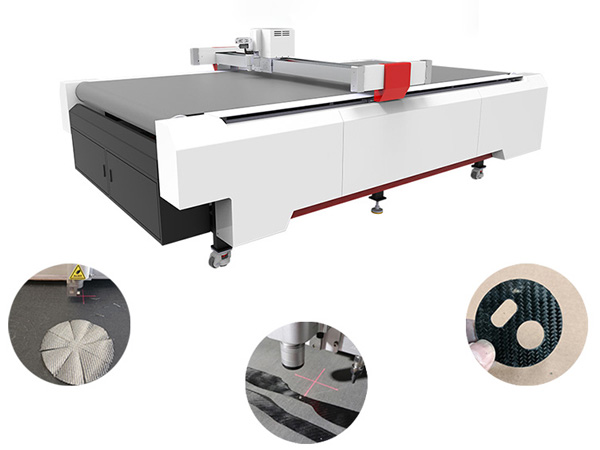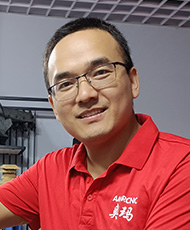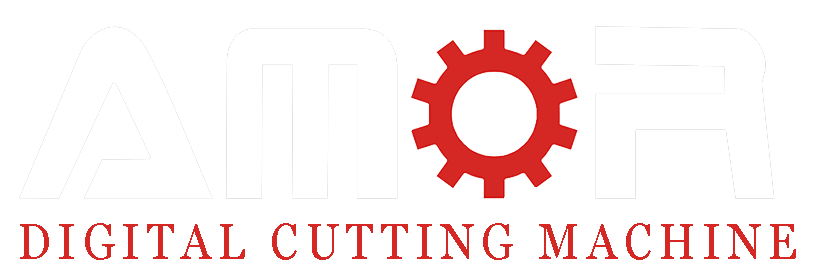Carbon fiber is the most common material among composite materials. It is widely used in aerospace, shipbuilding and vehicle manufacturing industries. An important process in the production process of carbon fiber is cutting. For some new friends in the industry, cutting is not a problem. It is very clear that during the development and production of carbon fiber cutting machines, we have conducted in-depth research on the cutting process of carbon fiber. How to achieve more perfect cutting of composite materials such as carbon fiber?

Limitations of Traditional Carbon Fiber Composite Cutting Methods
Traditional methods of cutting carbon fiber composites such as die cutting (mold punching) and CO2 laser cutting each have their own set of drawbacks. Below are some of the limitations associated with these methods:
Die Cutting (Mold Punching)
Initial Setup Cost: The cost of producing dies can be high, especially for intricate shapes.
Limited Flexibility: Once a die is manufactured, it can’t be modified. This limits flexibility for design changes.
Wear and Tear: Dies wear out over time and need to be replaced, incurring additional costs.
Material Waste: The die-cutting process can result in substantial material waste, especially when cutting complex shapes.
Edge Quality: The edges may require additional finishing processes to achieve the desired quality.
CO2 Laser Cutting
Heat-Affected Zone: The heat generated can affect the material properties near the cut, causing deformations.
Limited Thickness: Effective cutting is often limited to thinner sheets of carbon fiber composite.
Energy Consumption: CO2 laser cutting consumes a lot of energy, increasing operational costs.
Material Limitations: Certain types of carbon fiber composites may not be suitable for laser cutting.
Fume Emission: Cutting carbon fiber with a CO2 laser can produce toxic fumes that require effective ventilation.
Each of these methods has its own applications where it may excel, but when it comes to flexibility, efficiency, and quality, they often fall short compared to newer technologies like CNC oscillating knife cutting.
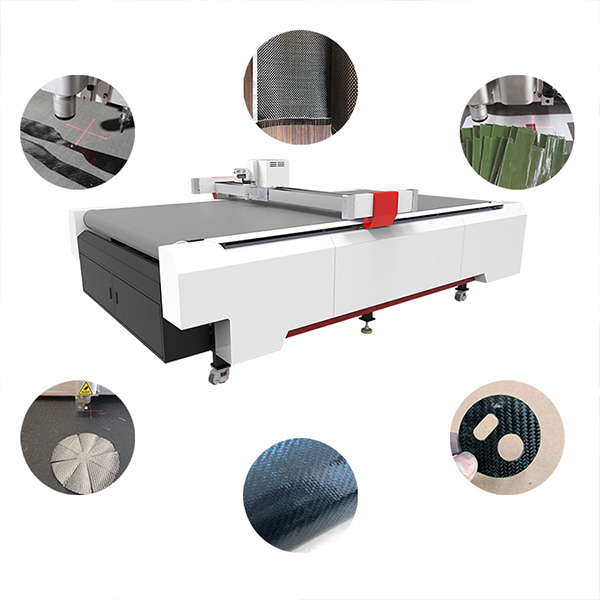
Advantages of Using Oscillating Knife Cutting Machines for Carbon Fiber
Utilizing an oscillating knife cutting machine for processing carbon fiber composites offers several benefits that address the limitations of traditional methods like die cutting and CO2 laser cutting. Below are some of the key advantages:
Precision and Accuracy
Oscillating knife technology allows for extremely precise cuts, even for intricate patterns and shapes.
Versatility and Flexibility
Easily adapt to design changes without the need for new dies or setups.
Capable of cutting various thicknesses and types of carbon fiber composites.
Energy Efficiency
Consumes less energy compared to laser cutting, resulting in lower operational costs.
No Heat-Affected Zone
The cutting process does not generate heat, thus avoiding deformations and alterations in material properties.
Improved Edge Quality
Produces clean, sealed edges that often do not require additional finishing, saving time and resources.
Reduced Material Waste
Advanced nesting software ensures optimal material utilization, reducing waste.
Safe and Environmentally Friendly
No toxic fumes are emitted during the cutting process, making it safer and more environmentally friendly.
Lower Setup and Operational Costs
No need for expensive dies or laser components.
Lower maintenance costs compared to traditional methods.
Oscillating knife cutting machines, particularly those equipped with high-quality components and advanced control systems, provide a compelling alternative for the cutting of carbon fiber composites, offering a balanced combination of precision, efficiency, and versatility.
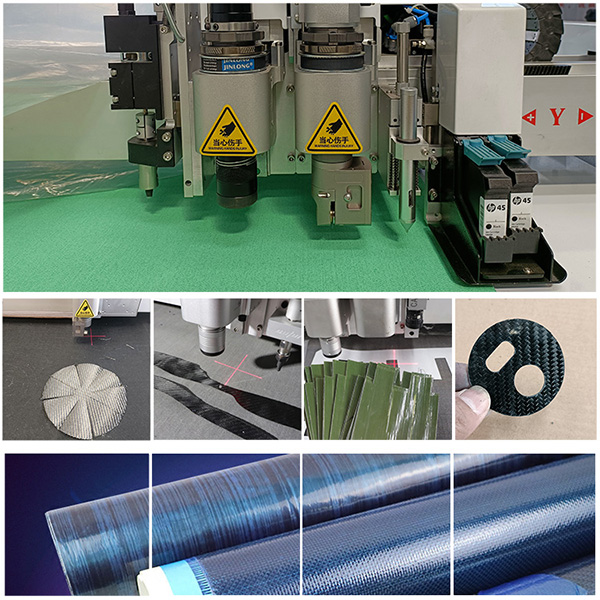
AMOR CNC Carbon Fiber Cutting Solution
Compared with traditional mold punching and CO2 laser cutting, AMOR CNC composite material cutting machine does not require molds, saves time and effort, and has accurate sample cutting, smooth edges, no jagged edges, no yellowing or burning, and no dust, smoke, or odor. , more environmentally friendly, easy to maintain, and low in use cost, which greatly shortens the development cycle of user styles and solves the problem of difficult production and processing of small batch orders.
Recommended machine models for carbon fiber cutting
AMOR1625BK series offers an advanced solution for carbon fiber and composite material cutting. Here are some of its key features:
Large Working Area
The machine comes with an effective processing area of 2500mm x 1600mm.
Rolling Platform and Automatic Feeding
Designed with a rolling platform and automatic feeding system, it eliminates the need for manual handling, thereby increasing work efficiency.
Customizable Width
The cutting width is customizable to meet specific project requirements.
Vacuum Suction System
The machine employs a vacuum suction system, making it easier to cut smaller samples.
Versatility in Material Cutting
Capable of cutting a wide range of composite materials, including pre-impregnated materials, unsaturated polyester, epoxy, phenolic, vinyl ester, glass fiber, carbon fiber, felts and fabrics, acrylic sheets, thick foam, asbestos pads, and coil footpads.
Industry Applications
Suitable for various industries, including aerospace, defense, armor, transportation, and infrastructure.
Advanced Control System
Utilizes Mitsubishi servo motors and screw mode for head control. The cutting depth is automatically adjusted through program-controlled motors.
Effective Material Holding
The vacuum suction and zoned suction system ensure that even smaller samples can be cut efficiently.
By offering a well-rounded set of features, the AMOR1625BK series provides an effective and efficient solution for carbon fiber and composite material cutting, enhancing your production capabilities.
| Recommended model: | AMOR1625BK |
| Cutting equipment power: | 2.5kw |
| Vacuum pump power: | 7.5kw |
| Voltage: | 220V/380V |
| Working size: | 1600x2500mm |
| Maximum material processing height: | 45mm |
| Maximum processing speed: | 1500mm/s |
| Bed structure: | welded one-piece |
| Cutting accuracy: | ±0.1mm |
| Positioning method: | High-definition CCD camera, automatic boundary recognition function |
| Automatic feeding: | yes |
| Application materials: | carbon fiber, glass fiber, soft glass, ablative materials, aramid fiber, asbestos fiber and other flexible materials |
Advantages of AMOR carbon fiber cutting machine
Robust Power System
Utilizes Mitsubishi servo motors paired with a precision reducer, featuring dual motor drive mode on the X-axis. This provides ample power for fast cutting tasks.
Full Range of Schneider Electric Components
To ensure consistent and stable performance, all electrical components, relays, AC contactors, and power switches are sourced from Schneider Electric, a renowned French brand.
Welded One-piece Frame
The frame uses a welded structure for enhanced stability and rigidity, preventing deformation during transit and operation.
Quick Tool Change Module
Features a universal tool holder that allows for a quick and easy tool change, catering to different material requirements.
Comprehensive Tool Options
A range of cutting tools, including milling cutters, oscillating knives, beveled knives, drag knives, creasing knives, half knives, and wheel cutters, allows for versatile material cutting.
Honeycomb Aluminum Table
Durable and long-lasting without deformation. The vacuum suction design provides powerful suction, making it easy to handle even small samples.
Felt Table Surface
Imported material ensures good ventilation, wear resistance, and a long life, thereby minimizing operating costs.
Safe Operating Environment
Equipped with an infrared automatic sensing safety device to protect the operator during high-speed movements, while also preventing material waste.
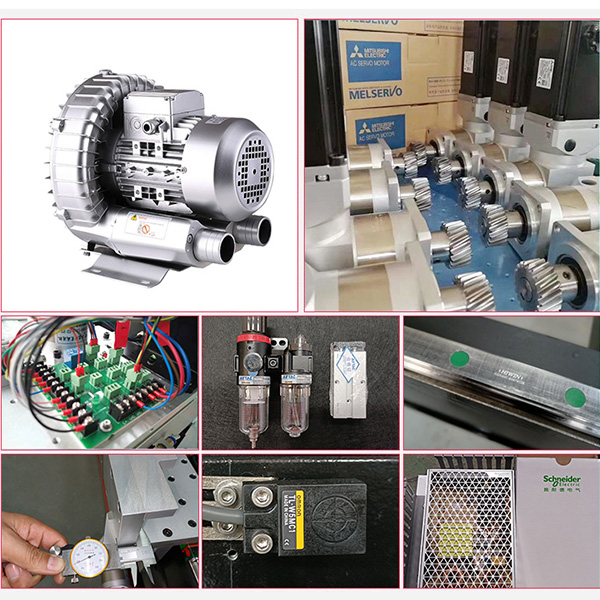
Complete Automatic Carbon Fiber Cutting in 5 Steps
Design Input: The user inputs the design file into the machine’s software, selecting the desired dimensions and shape for the carbon fiber material.
Tool Selection: The software automatically selects the oscillating knife best suited for cutting carbon fiber, ensuring precision and efficiency.
Material Placement: The user places the carbon fiber sheet on the vacuum suction table, which securely holds the material in place during cutting.
Cutting Process: Upon confirming the settings, the machine begins the cutting operation. The oscillating knife moves swiftly and accurately, following the design path to cut the carbon fiber.
Final Inspection: After cutting, the machine automatically halts for the user to remove and inspect the cut pieces. The edges are smooth, and the dimensions are precise, thanks to the high-frequency oscillating technology.
In just these 5 steps, the AMOR Oscillating Knife Cutting Machine delivers a fast, precise, and efficient solution for cutting carbon fiber composites.

